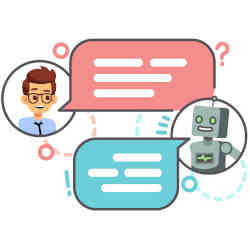
Before revolutionizing customer service, chatbots will need to deal with marked pushback from consumers, many of whom count themselves underwhelmed by the technology's current capabilities.
New university research, for example, reveals that sales chatbots actually drove down closed deals by nearly 80% — once potential customers learned they were dealing with a robot and not a human.
"When customers know the conversational partner is not a human, they are curt and purchase less because they think the bot is less knowledgeable and less empathetic," says Xueming Luo, a co-author of the study and a professor specializing in computerized marketing at Temple University.
For many who have dealt with the regular frustration of conversations with robots that swiftly arrive at dead ends, Luo's findings probably come as no surprise. In fact, a July 2019 market research report from Gartner uncovered similar negative sentiment on chat technology.
Declaring the market 'awash' in low-end chat technology, Gartner researchers warned that too many chatbots currently deliver a poor user experience, creating friction between customer and company. Moreover, too many of these same implementations also deliver no real business benefit, according to the researchers. Gartner's prognosis: Look for more of the same from the technology in the short term, with scores of low-end commercial chatbots continuing to tarnish the technology's reputation and continuing to regularly disappoint consumers.
Yet another group of researchers, at market research firm Forrester, arrived at a similar conclusion. Specifically, Forrester found that 48% of customer experience experts at companies say that chatbots in use at their businesses are causing them to lose customers, because the technology disappoints.
"Broadly, this is echoing the work of Luger et al," says Tom Feltwell, a postgraduate associate specializing in computer and information sciences at Northumbria University. "When users know it's a chatbot, they set their expectations accordingly," Feltwell says.
Like many researchers, Feltwell blames the uncertain future for chat technology on first-generation chatbox iterations, along with early implementations of Interactive Voice Response (IVR). Too often, both technologies seemed to promise so much and deliver so little, he says.
"Interactive Voice Response was/is notorious for not understanding the user's response, and this poor user experience has stuck with many people," Feltwell says.
However, there may be other factors disenchanting consumers, including a knee-jerk reluctance to be wary of new technology, according to Petter Bae Brandtzaeg, chief scientist specializing in media and communication at SINTEF, one of Europe's largest independent research organizations.
"Chatbots are a very new interface — at least in shopping," Brandtzaeg says. "People in general are not used to this kind of interface. So, this newness of chatbot interaction may also explain partly the results. People tend to be skeptical towards new modes of interactions and technology."
Brandtzaeg also notes that implementations of similar-grade chatbot technology in other settings have actually received a warm welcome. "I'm myself leading an extensive project about how mental health chatbots can help and guide young people, even when the chatbot's identity is disclosed," he says.
"What I see is that chatbots that are developed to support small talk and mental health guidance may change how a new generation of online users receive social support and how friendships are formed. They actually prefer chatbots over machines, because chatbots don't do judgements, and can give instant social support anytime and anywhere."
Fortunately, many early adopters of ecommerce chatbots have gotten the message that their tech is too often an epic yawn. In response, they're working furiously to develop next-generation chatbots that are smarter, more efficient, and more customer-friendly, according to Feltwell.
The success of such next-generation chatbots will hinge on enhancing the sophistication of Natural Language Processing (NLP), the tech that is already wowing customers through high-end virtual assistants like Amazon's Alexa, Apple's Siri and Google's Google Assistant.
"NLP's main shortcoming is the training required in order for it to understand a wide range of language," Feltwell says. "For example, an inquiry about a product can be phrased in multiple different ways. One customer might ask, 'Does this product contain cotton?' But another might say, 'I can't buy anything that contains cotton, I hope this one doesn't'." Therefore, training the NLP with a broad range of language is important.
"This is something the smart home assistant companies, Amazon, Google, Apple, have been doing for a few years now. Thus, their products are becoming more adept at understanding queries and some of the more obscure things we say and ask."
Feltwell says it is "simply a matter of time before these powerful NLP engines are available for use in ecommerce and other products."
Forrester's researchers agree, observing that 64% of the specialists in customer experience they surveyed plan to 'up their game' in chat technology, predicting they will be rolling out AI-driven chatbots within the next two years.
While admirable, that goal that may overly optimistic, says Forrester.
Feltwell agrees. "It's not infeasible that such AI (artificial intelligence)-driven chatbots would be available within the next five years." He adds that chatbots with limited sophistication will continue to proliferate in the short term, as there is plenty of room in the market, for example, for chatbots that offer simple information, like bots that provide statistics on a sports match fit.
In addition, Feltwell says, while "it's important to know that someone at the company cares about your complaint," he says it is "less important that the person you're getting your baseball stats from is empathetic. The focus there is on usefulness," which current chat technology can handle.
Juniper Research, another market research firm, echoes that outlook. Conceding chatbot tech is often "derided," Juniper in May 2019 predicted revenues from sales of chatbots to retailers will double every year through 2023, when it will reach $112 billion.
Joe Dysart is an Internet speaker and business consultant based in Manhattan, NY, USA



Join the Discussion (0)
Become a Member or Sign In to Post a Comment